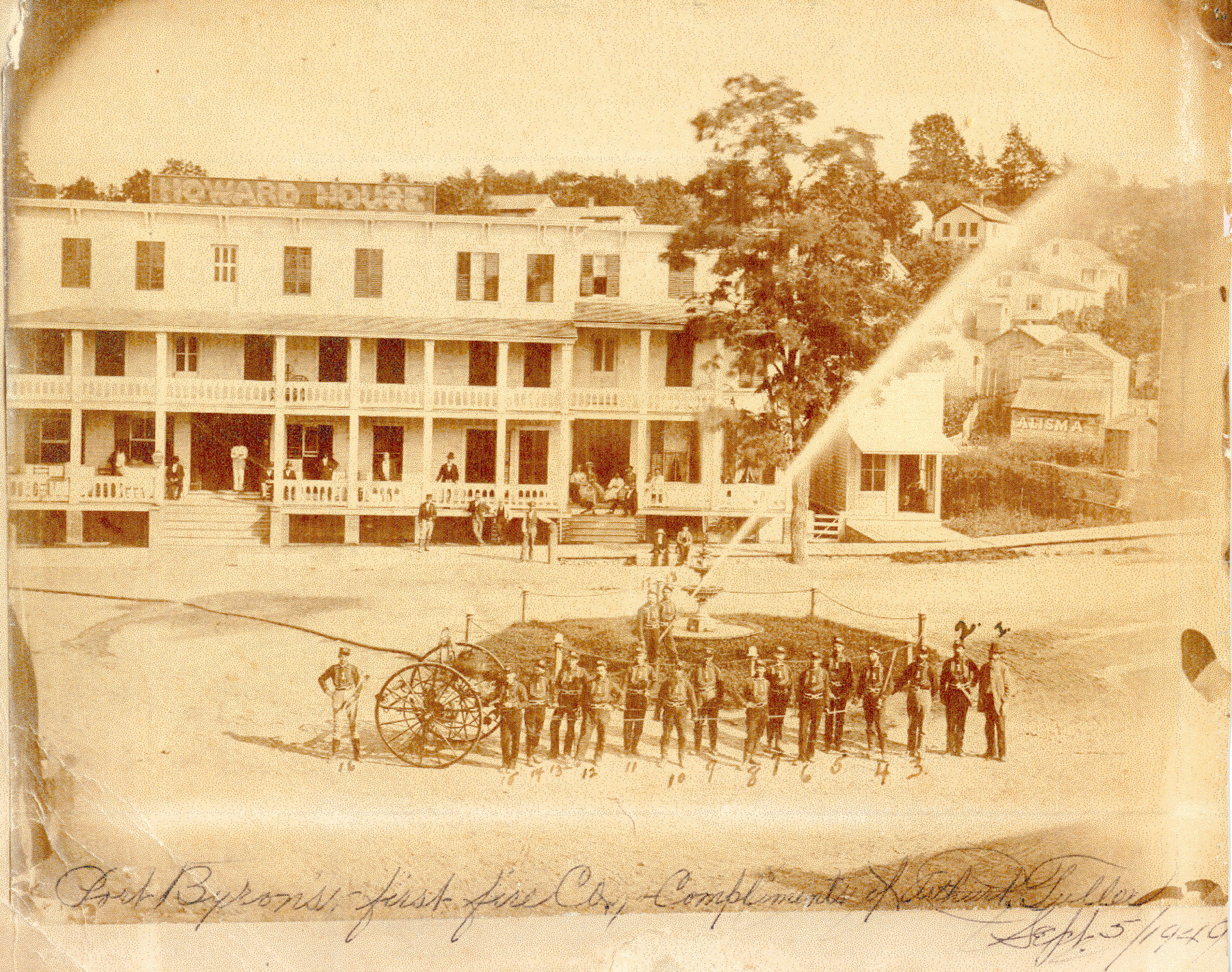Fire was a way of life for our early village and town residents. It was used to cook, heat, power steam engines, run a forge and so much more. And there were times when these utilitarian fires became destructive. A flames and burning embers would spread the fire to the nearby buildings, and this was especially so in the tight confines of the business district. In the early days, the methods to fight the fires was fairly basic. We have all heard about the bucket brigade as all the neighbors rushed to fill leather buckets and hand these along a chain of people. At the end of the chain, a person would toss the water on the fire and then toss back the empty bucket and the process would start again. Along with buckets, a supply of wooden ladders were kept on hand in order to elevate the firemen. Needless to say, the fire usually won the battle, and at the best, the firemen of the period would hope to slow the spread of fire and maybe save a few lives and precious items before the building burned to the ground.
Our collection of newspapers from the 1800s is very thin, however the news reports of any large fires would often be carried in newspapers up and down the canal as many of the local businessmen were well known across the state. In this way we know that in 1838 a fire consumed the businesses of Edger Eaman, and James Pine, and the homes of Walter Smith and Hannah Brown. James Pine rebuilt his tavern only to have to burn again in 1855 along with other businesses. In 1858 what was at one time the largest grain mill in the state burned. In 1868 the entire Hatfield Block burned. In this building was the office of the Times, which helps to explain our historical void of local historical newspapers. Two years later another large fire burned the dry-goods store of William Smith. Smith had also lost his business in the 1855 fire.
So how did the village residents fight these fires? In 1837 the businessmen of the village raised $150 to purchase ladders for the purpose of fighting fires and soon after, a “Hook and Ladder” company was organized. The 1870 fire is credited with the formal organization of the Port Byron Protective Hose Company Number 1. The village also constructed a small reservoir high on the hill behind the home of William Halsey (about where the water tower is today).

The reservoir supplied small 4 and 6 inch pipes that were buried throughout the business area of the village and this provided some level of protection. If you look at some of the early postcards you can spot fire hydrants. However, aside from a hand-drawn hose cart, the fire department had limited means to fight any fires. In 1876 a large fire consumed the canal side coal-yard of Abner Armstrong and Sons, and the steeple of the Presbyterian Church. Another large fire in 1913 destroyed the Tatgenhorst Block in the downtown. To help fight this fire, Auburn firemen (and their engines) were called in and they were credited for stopping the spread to the neighboring buildings.

In 1890 the village built the two story firehouse on South Main Street. This building was south of the Rt 31/38/Main Street intersection in a row of buildings that also housed the mincemeat plant. The firehouse had a large hose drying tower where the canvas hose could be hung to dry to reduce the chance of dry-rot.

In the Port Byron Chronicle of March 3, 1923, the village businessmen wrote that Port Byron needed modern and up-to-date fire fighting apparatus. In-spite of all the fires, the firemen were still responding with the old man-drawn hose cart. In response the village purchased a Ford chassis from Harvey Ware. He and Clarence Hunter built a fire-engine that could carry hose, ladders, and fire-fighting chemicals for $500.
Whether this Ford was not up to the task, or perhaps demonstrated the need for more modern equipment, in 1924 the village purchased it’s first real fire-engine, a 1923 Sanford truck chassis that was outfitted with a Obenchain-Boyer pump. The delivery of the truck in 1925 was a big deal and firemen from Auburn, Weedsport, Skaneateles, Savannah and other departments came to see the new pumper-truck be put through it’s tests. The truck was taken to the Green Street bridge where it pumped 500-gallons-per-minute out of the Outlet for three hours straight. It was then moved to the highest point on King Street where it pumped from the hydrant. This Sanford pushed the village fire-department into the modern era.

The next truck was purchased in 1941 and somehow it was designated only to fight fires in the village limits. Surprisingly little fanfare was given this truck, although it was mentioned that the Sanford was almost 20-years-old. In November of 1945, the Village board purchased a new Buffalo fire engine, which had a larger tank and was better for rural fires where there were no water lines. It was expected that the truck would be delivered in 150-days. Fourteen months later the new truck arrived in February 1947. While they were waiting for their new fire truck, the voters decided to build a new fire house and municipal building.

The 1947 firehouse was in use up to 1974 when a even newer firehouse was built next door.


In 1944 the name was changed from the Protective Hose Company to the Port Byron Fire Department. This year the Port Byron Fire Department celebrates it’s 150th birthday and we thank all the men and women who give of themselves to keep us all safe.
(Note- there were many other fires that have shaped the village that were not mentioned here.)
